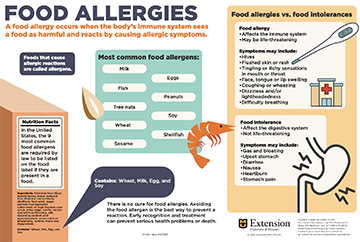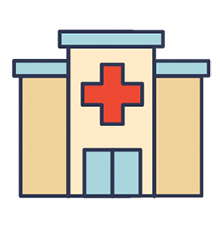Editor’s note
The following abstract describes a publication that is available as a downloadable PDF.
See the companion publication N1148, Food Allergies handout.

This poster addresses the importance of food allergy awareness and tips for managing allergies.
Topics
- Anaphylaxis shock
- Common food allergens
- Allergic reactions
- Food labels
- Cooking
- Medical ID bracelet
- Medication
- SNAP
Pages
- One 36 x 24 inches poster
See poster content below.
Food Allergies
A food allergy occurs when the body’s immune system sees a food as harmful and reacts by causing allergic symptoms.
Foods that cause allergic reactions are called allergens.

Most common food allergens:
- Milk
- Eggs
- Fish
- Peanuts
- Tree nuts
- Soy
- Wheat
- Shellfish
- Sesame
In the United States, the nine most common food allergens are required by law to be listed on the food label if they are present in a food.
"Contains: Wheat, Milk, Egg and Soy"
There is no cure for food allergies. Avoiding the food allergen is the best way to prevent a reaction. Early recognition and treatment can prevent serious health problems or death.
Food allergies vs. food intolerances

Food allergy
- Affects the immune system
- May be life-threatening
Symptoms may include:
- Hives
- Flushed skin or rash
- Tingling or itchy sensations in mouth or throat
- Face, tongue or lip swelling
- Coughing or wheezing
- Dizziness and/or lightheadedness
- Difficulty breathing
Food intolerance
- Affects the digestive system
- Not life-threatening
Symptoms may include:
- Gas and bloating
- Upset stomach
- Diarrhea
- Nausea
- Heartburn
- Stomach pain
Funded in part by USDA SNAP.
For more information, call MU Extension’s Show Me Nutrition line at 1-888-515-0016.
Need help stretching your food dollars? Contact your local resource center or go online to mydss.mo.gov/food-assistance/food-stamp-program.